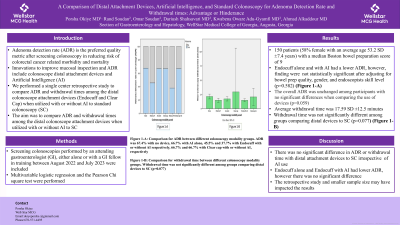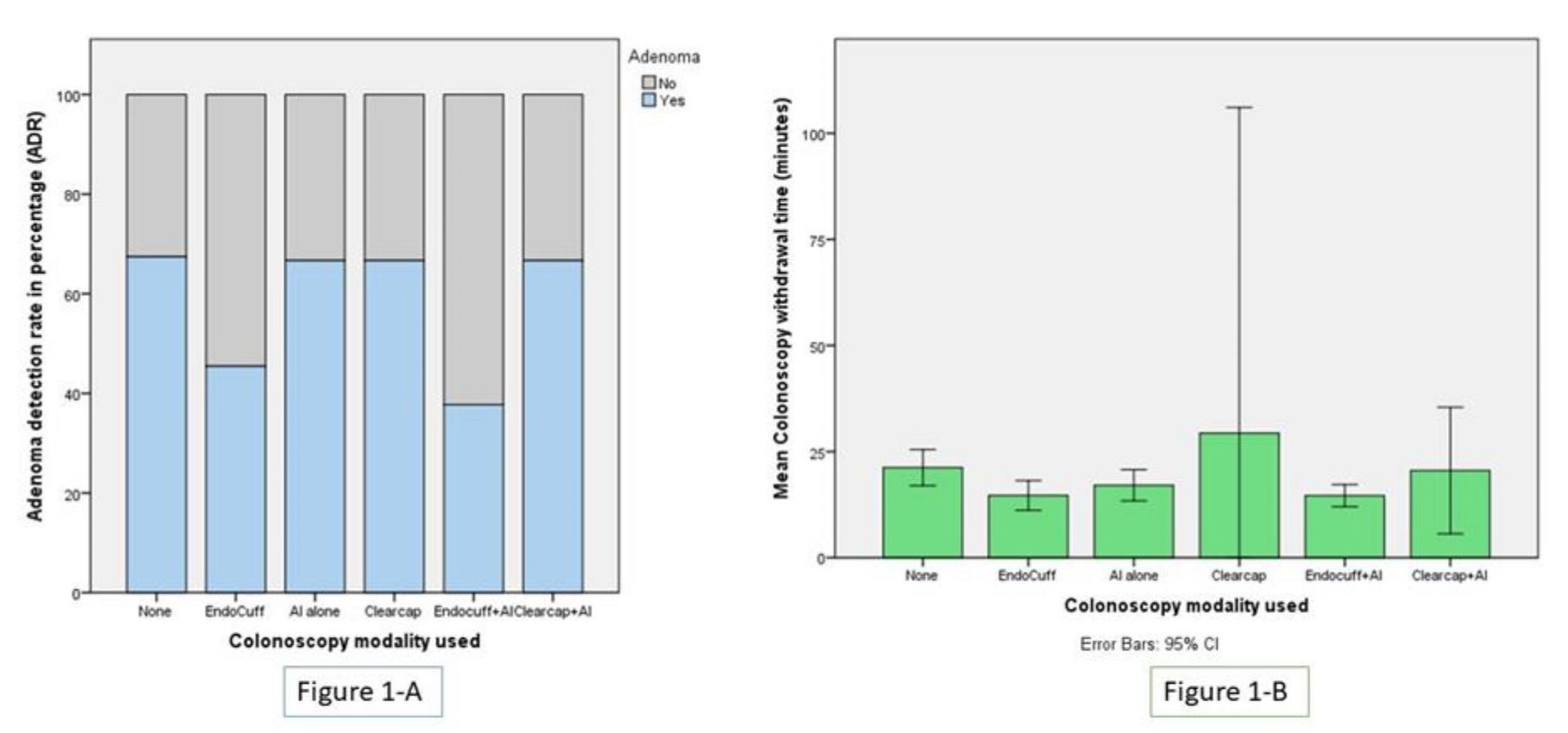Tuesday Poster Session
Category: General Endoscopy
P4096 - A Comparison of Distal Attachment Devices, Artificial Intelligence, and Standard Colonoscopy for Adenoma Detection Rate and Withdrawal Times: Advantage or Hinderance
Tuesday, October 29, 2024
10:30 AM - 4:00 PM ET
Location: Exhibit Hall E

Has Audio

Porsha Okiye, MD, MS, MD
Augusta University Medical Center
Augusta, GA
Presenting Author(s)
Porsha Okiye, BS, MS, MD1, Rand Soudan, 2, Omar Soudan, 2, Dariush Shahsavari, MD1, Kwabena O. Adu-Gyamfi, MD3, Ahmad Alkaddour, MD4
1Augusta University, Augusta, GA; 2University of Sharjah, Dubai, Dubai, United Arab Emirates; 3Medical College of Georgia, Augusta University, Augusta, GA; 4Medical College of Georgia at Augusta University, Augusta, GA
Introduction: Adenoma detection rate (ADR) is the preferred quality metric after screening colonoscopy in reducing risk of colorectal cancer related morbidity and mortality. The ability to detect adenomas during colonoscopy depends on multiple factors including the examination technique, endoscopist skill, and the quality of bowel preparation. Innovations to improve mucosal inspection and ADR include colonoscope distal attachment devices and Artificial Intelligence (AI). We performed a single center retrospective study to compare ADR and withdrawal times among the distal colonoscope attachment devices (Endocuff and Clear Cap) when utilized with or without AI to standard colonoscopy (SC).
Methods: Screening colonoscopies performed by an attending gastroenterologist (GI), either alone or with a GI fellow in training between August 2022 and July 2023 were included. The aim was to compare ADR and withdrawal times among the distal colonoscope attachment devices when utilized with or without AI to SC. Multivariable logistic regression and the Pearson Chi square test were performed.
Results: A total of 150 patients (58% female with an average age 53.2 SD ±7.4 years), underwent index screening colonoscopy with a median Boston bowel preparation score of 9. Average withdrawal time was 17.59 SD ±12.5 minutes. There were no significant differences in ADR when comparing SC to distal attachment devices with or without AI (p=0.046). However, the overall ADR was improved. Notably, there were slight variations among devices. Endocuff alone and Endocuff with AI had a reduced ADR compared to Clear cap without or without AI. ADR was 67.4% with no device, 66.7% with AI alone, 45.5% and 37.7% with Endocuff with or without AI respectively, 66.7% and 66.7% with Clear cap with or without AI, respectively (Figure 1-A). Withdrawal time was not significantly different among groups comparing distal devices to SC (p=0.077) (Figure 1-B). There was no difference in ADR after adjusting for colonoscopy device used (p=0.060), bowel prep quality (0.989), patient’s gender (0.068), experience level of endoscopist (p=0.396) (OR 0.84, 95% CI 0.7-1.01).
Discussion: In this study, there was no significant difference in ADR or withdrawal time with distal attachment devices to SC regardless of AI use, however, Endocuff alone and Endocuff with AI trended towards lower ADR. The smaller sample size may have impacted the results, therefore, large-scale multicenter studies are required to evaluate the utility of distal attachment devices and AI.

Disclosures:
Porsha Okiye, BS, MS, MD1, Rand Soudan, 2, Omar Soudan, 2, Dariush Shahsavari, MD1, Kwabena O. Adu-Gyamfi, MD3, Ahmad Alkaddour, MD4. P4096 - A Comparison of Distal Attachment Devices, Artificial Intelligence, and Standard Colonoscopy for Adenoma Detection Rate and Withdrawal Times: Advantage or Hinderance, ACG 2024 Annual Scientific Meeting Abstracts. Philadelphia, PA: American College of Gastroenterology.
1Augusta University, Augusta, GA; 2University of Sharjah, Dubai, Dubai, United Arab Emirates; 3Medical College of Georgia, Augusta University, Augusta, GA; 4Medical College of Georgia at Augusta University, Augusta, GA
Introduction: Adenoma detection rate (ADR) is the preferred quality metric after screening colonoscopy in reducing risk of colorectal cancer related morbidity and mortality. The ability to detect adenomas during colonoscopy depends on multiple factors including the examination technique, endoscopist skill, and the quality of bowel preparation. Innovations to improve mucosal inspection and ADR include colonoscope distal attachment devices and Artificial Intelligence (AI). We performed a single center retrospective study to compare ADR and withdrawal times among the distal colonoscope attachment devices (Endocuff and Clear Cap) when utilized with or without AI to standard colonoscopy (SC).
Methods: Screening colonoscopies performed by an attending gastroenterologist (GI), either alone or with a GI fellow in training between August 2022 and July 2023 were included. The aim was to compare ADR and withdrawal times among the distal colonoscope attachment devices when utilized with or without AI to SC. Multivariable logistic regression and the Pearson Chi square test were performed.
Results: A total of 150 patients (58% female with an average age 53.2 SD ±7.4 years), underwent index screening colonoscopy with a median Boston bowel preparation score of 9. Average withdrawal time was 17.59 SD ±12.5 minutes. There were no significant differences in ADR when comparing SC to distal attachment devices with or without AI (p=0.046). However, the overall ADR was improved. Notably, there were slight variations among devices. Endocuff alone and Endocuff with AI had a reduced ADR compared to Clear cap without or without AI. ADR was 67.4% with no device, 66.7% with AI alone, 45.5% and 37.7% with Endocuff with or without AI respectively, 66.7% and 66.7% with Clear cap with or without AI, respectively (Figure 1-A). Withdrawal time was not significantly different among groups comparing distal devices to SC (p=0.077) (Figure 1-B). There was no difference in ADR after adjusting for colonoscopy device used (p=0.060), bowel prep quality (0.989), patient’s gender (0.068), experience level of endoscopist (p=0.396) (OR 0.84, 95% CI 0.7-1.01).
Discussion: In this study, there was no significant difference in ADR or withdrawal time with distal attachment devices to SC regardless of AI use, however, Endocuff alone and Endocuff with AI trended towards lower ADR. The smaller sample size may have impacted the results, therefore, large-scale multicenter studies are required to evaluate the utility of distal attachment devices and AI.

Figure: Figure 1:Comparison for ADR (1-A) and withdrawal time (1-B) between different colonoscopy modality groups.
Disclosures:
Porsha Okiye indicated no relevant financial relationships.
Rand Soudan indicated no relevant financial relationships.
Omar Soudan indicated no relevant financial relationships.
Dariush Shahsavari indicated no relevant financial relationships.
Kwabena Adu-Gyamfi indicated no relevant financial relationships.
Ahmad Alkaddour indicated no relevant financial relationships.
Porsha Okiye, BS, MS, MD1, Rand Soudan, 2, Omar Soudan, 2, Dariush Shahsavari, MD1, Kwabena O. Adu-Gyamfi, MD3, Ahmad Alkaddour, MD4. P4096 - A Comparison of Distal Attachment Devices, Artificial Intelligence, and Standard Colonoscopy for Adenoma Detection Rate and Withdrawal Times: Advantage or Hinderance, ACG 2024 Annual Scientific Meeting Abstracts. Philadelphia, PA: American College of Gastroenterology.
